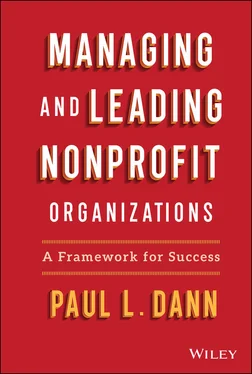Paul L. Dann - Managing and Leading Nonprofit Organizations
Здесь есть возможность читать онлайн «Paul L. Dann - Managing and Leading Nonprofit Organizations» — ознакомительный отрывок электронной книги совершенно бесплатно, а после прочтения отрывка купить полную версию. В некоторых случаях можно слушать аудио, скачать через торрент в формате fb2 и присутствует краткое содержание. Жанр: unrecognised, на английском языке. Описание произведения, (предисловие) а так же отзывы посетителей доступны на портале библиотеки ЛибКат.
- Название:Managing and Leading Nonprofit Organizations
- Автор:
- Жанр:
- Год:неизвестен
- ISBN:нет данных
- Рейтинг книги:4 / 5. Голосов: 1
-
Избранное:Добавить в избранное
- Отзывы:
-
Ваша оценка:
- 80
- 1
- 2
- 3
- 4
- 5
Managing and Leading Nonprofit Organizations: краткое содержание, описание и аннотация
Предлагаем к чтению аннотацию, описание, краткое содержание или предисловие (зависит от того, что написал сам автор книги «Managing and Leading Nonprofit Organizations»). Если вы не нашли необходимую информацию о книге — напишите в комментариях, мы постараемся отыскать её.
Managing and Leading Nonprofit Organizations: A Framework For Success
Managing and Leading Nonprofit Organizations: A Framework For Success
Managing and Leading Nonprofit Organizations — читать онлайн ознакомительный отрывок
Ниже представлен текст книги, разбитый по страницам. Система сохранения места последней прочитанной страницы, позволяет с удобством читать онлайн бесплатно книгу «Managing and Leading Nonprofit Organizations», без необходимости каждый раз заново искать на чём Вы остановились. Поставьте закладку, и сможете в любой момент перейти на страницу, на которой закончили чтение.
Интервал:
Закладка:
Simply going with the gravitational pull means that you are acting without critical thought regarding the actions that you are undertaking. Being antigravitational means that you are taking stock in the current situation and that you have made a mindful decision to move against or away from the direction that is formed by the norms found within the cultural context. For example, growing up you may have received messages from your parents and the people around you that you should not create a problem: “Don't make a fuss,” “It's not that big a deal,” or “Mind your own business” could be a tape that plays over and over again in your head. The gravitational pull in this context would be to simply keep quiet and avoid raising any concern. This pull follows you into your work and into your leadership practice. To be antigravitational you would need to move against this gravitational pull and instead work to ensure that you speak up, that you work to address concerns as well as understand that getting involved is your business.
To be gravitational is to risk action without thought. To be antigravitational is to ensure that you have exercised a thoughtful examination of your and others' actions to determine whether a different course of action—one that is against the flow—is the better course of action. The key here in understanding this perspective is to understand the role that awareness and mindfulness plays in determining whether to be gravitational or antigravitational. The notion is not to always be a contrarian, but rather to ensure that your leadership practice includes the mindful consideration of your and your team's actions. Understand that there are times when you must go against the flow, and that in order to know when to do this you have to be aware of exactly what the flow is and where it comes from.
Second Practice Perspective: The Long View
Tomlinson (2007) underscores that we find ourselves in a culture of speed, where there is a continual move toward getting things done more quickly. Faster is better, getting it done is key, and arriving at the destination is held as paramount. The need for immediacy has become a driving force in our society. Consider how food is prepared, packaged, and ready to go, even mailed to you in portions that you can drop in a pot. Think about the desire for faster, more efficient forms of transportation and how impatient we have all become when we are ready for something. One only needs to look at the phenomenon of same‐day delivery, books and movies on demand, and push‐button solutions to see that our cultural desire for immediacy has become pervasive. The impact of this culture of immediacy goes beyond the delivery of packages and the use of high‐speed internet, extending as well into the very way in which we conduct ourselves professionally. We quickly become impatient and want the end rewards even before we have begun the journey.
Successful leadership requires a different perspective. We must be antigravitational and recognize that many things come over time. It is not possible to push a button or flick a switch to become effective as a leader. To develop as a leader and a strong manager you must practice, pursue learning opportunities, and avail yourself of leadership experiences—experiences that help to ensure both the presence of practice and learning opportunities.
In my work with aspiring leaders, I often find myself asking them the question “Where are you going?” I generally receive a puzzled look, to which I respond, “No, where are you going?” The question becomes a point of reflection. “Why are you in such a rush?” To stop and consider what one is doing and where one is going and the pace at which one is pursuing their journey is key. We rush, go, and do, but we rarely take a moment to consider what we are doing and why we are rushing.
Taking the long view requires that we acknowledge that our goals and objectives in leadership will take time—that there is little benefit to rushing and those who have a long view will have an advantage over those who feel they must already be at their destination. Consider the success of the marathon runner who understands that their effort requires a different strategy than that of the runner in the 100‐yard dash. To have a long‐view perspective is to be tenacious in your pursuit of leadership and managerial prowess. Do not give up and do not burn yourself out by setting unrealistic expectations about what it will take to advance your leadership practice.
Third Practice Perspective: It's the Journey, Not the Destination
Just as we need to learn to take the long view, we should strive to understand the role that the journey plays in your leadership development. Because we become obsessed with getting there and reaching the destination, we often forget the importance of the journey itself. Effective leaders understand that the journey they have embarked upon in the development of their practice represents simultaneously an opportunity to learn and grow as well as a source of enjoyment. Do not miss out on the ability to enjoy as well as revel in the path you have chosen to advance your growing leadership practice. One strategy to help ensure this is to work toward being present in your day‐to‐day work. Rather than being driven by the outcome or the goal take time to appreciate what you experience along the way.
I think, for example, about the amazing things I encounter in my own nonprofit leadership practice every day. For example, when the COVID‐19 pandemic began, the six‐month leadership academy that I offered for aspiring leaders was stalled and looked like it would be doomed for the next year. The goal of advancing our leaders seemed sidelined, until one of my team members suggested I simply provide this intensive face‐to‐face leadership training online.
The idea began as a seed and grew to become a full six‐month online synchronous leadership development training. And while we achieved our goal of training another 25 employees, I have to say that the opportunity to refine and deliver the curriculum online for the first time was a surprising learning experience for me and extremely rewarding in the end for our participants. Do not allow the gravitational pull of getting to your destiny keep you from being antigravitational and enjoying the journey. Each challenge can become an opportunity for learning and growth, even the difficult challenges!
Fourth Practice Perspective: Leverage Serendipity
When I first began working as a case manager for a small nonprofit organization, I developed a close friendship with another case manager on the team. We would often attend meetings together and ultimately began socializing after work. During those times we would spend time talking about our work and our plans for the future. I remember being struck by the fact that he felt the agency was a dead‐end place to work. He said, “There's not much going on here, with only four programs and just a few opportunities for promotion and professional development. I'm not sure how long I'm going to stick around.” I recall being dumbfounded by his comments. “Really?” I replied, “I don't see it that way—in fact, I think there's a lot of potential here.” He looked at me in the skeptical way people do when they feel they are a bit more in the know.
It was not long before he moved onto another case manager position with another nonprofit service organization, and just about the time he moved on, I was offered the opportunity to run my first program. I thought long and hard about the fact that we worked in the same place and shared similar skills and education, but I was the one who ended up with the opportunity to advance within the organization. Just dumb luck, right? Well, no, I don't think so. I think I was lucky but unlike my colleague I was also ready for the opportunity. The posture I took, that possibilities were quite present within the organization, laid the groundwork for me to jump on the chance to advance. I suspect that others too experienced my demeanor as one that would be receptive to the possibility of taking on a leadership role.
Читать дальшеИнтервал:
Закладка:
Похожие книги на «Managing and Leading Nonprofit Organizations»
Представляем Вашему вниманию похожие книги на «Managing and Leading Nonprofit Organizations» списком для выбора. Мы отобрали схожую по названию и смыслу литературу в надежде предоставить читателям больше вариантов отыскать новые, интересные, ещё непрочитанные произведения.
Обсуждение, отзывы о книге «Managing and Leading Nonprofit Organizations» и просто собственные мнения читателей. Оставьте ваши комментарии, напишите, что Вы думаете о произведении, его смысле или главных героях. Укажите что конкретно понравилось, а что нет, и почему Вы так считаете.











